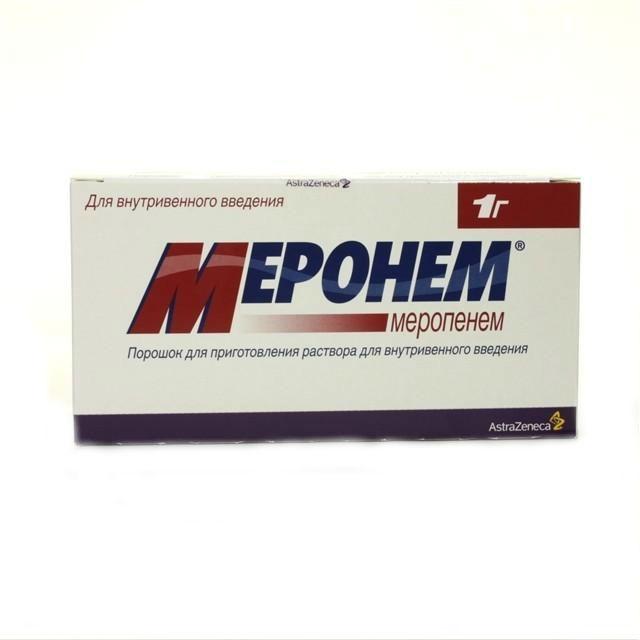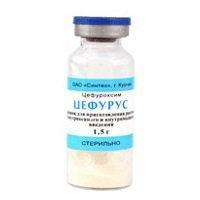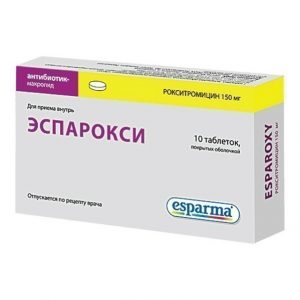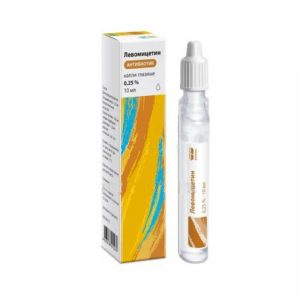Description
Release form
Powder for solution for intravenous administration.
Packing
10 bottles
Pharmacological action
Meronem has an antibacterial effect.
Contraindications
hypersensitivity to meropenem or other drugs of the carbapenem group in the anamnesis of
severe hypersensitivity (anaphylactic reactions, severe skin reactions) to any antibacterial agent that has a beta-lactam structure (i.e., children) .
Caution: concomitant use with potentially nephrotoxic drugs in patients with gastrointestinal complaints (diarrhea), especially those suffering from colitis.
Pregnancy and lactation
Pregnancy
The safety of using Meronem ® in women during pregnancy has not been studied. Animal studies have not shown any adverse effects on the developing fetus.
Meronem ® should not be used during pregnancy, unless the potential benefit to the mother from its use outweighs the potential risk to the fetus. In each case, the drug should be used under strict medical supervision.
Lactation
Meropenem is determined in very low concentrations in the breast milk of animals. Meronem ® should not be used during breastfeeding, unless the potential benefit to the mother from the use of the drug outweighs the potential risk to the baby. Having assessed the benefit for the mother, a decision should be made whether to stop breastfeeding or stop taking Meronem ®.
Special instructions
There is no experience with the use of the drug in pediatric patients with neutropenia or with primary or secondary immunodeficiency.
As with other antibiotics when using meropenem in monotherapy mode, patients who are in critical condition with a detected lower respiratory tract infection caused by Pseudomonas aeruginosa or if it is suspected are recommended to conduct a regular sensitivity test.
In rare cases, with the use of Meronem ®, as with almost all antibiotics, the development of pseudomembranous colitis is observed, which can vary in severity from mild to life-threatening forms. It is important to remember the possibility of developing pseudomembranous colitis in case of diarrhea with the use of Meronem ®.
There are clinical and laboratory signs of cross-allergic reactions between other carbapenems and beta-lactam antibiotics, penicillins and cephalosporins. There are rare reports of cases of hypersensitivity reactions (including those with a fatal outcome) when using the drug Meronem ®, as well as other beta-lactam antibiotics (see section “Side effects”). Before starting treatment with meropenem, it is necessary to carefully examine the patient, paying particular attention to the history of hypersensitivity to beta-lactam antibiotics. Meronem ® should be used with caution in patients with a history of such phenomena. If an allergic reaction to meropenem occurs, it is necessary to stop the administration of the drug and take appropriate measures.
The use of Meronem ® in patients with liver disease should be closely monitored for transaminase activity and bilirubin concentration.
As with other antibiotics, excessive growth of insensitive microorganisms is possible, in connection with which constant monitoring of the patient is necessary.
The prevalence of acquired antibiotic resistance of various pathogens may vary depending on the region and time, it is desirable to have up-to-date information on the resistance of common pathogens in a particular region, especially in the treatment of severe infections. If the resistance is such that the effectiveness of the drug against at least some infections becomes doubtful, you should consult an expert.
Co-administration of Meronem ® and valproic acid is not recommended.
The use of the drug in infections caused by methicillin-resistant staphylococcus is not recommended.
Influence on the ability to drive a car and work with equipment. There have been no studies of the effect of Meronem ® on the ability to drive a car and other equipment. However, it should be borne in mind that when taking Meronem ®, headache, paresthesia, and seizures may occur.
Composition
1 vial contains:
Active ingredient: meropenema trihydrate 1, 14 g, which corresponds to the content of meropenem 1 g.
Excipients: sodium carbonate (anhydrous) – 208 mg.
Dosage and administration
The drug Meronem is intended for intravenous administration. Dosage 20-40 mg / kg body weight every 8 hours, maximum dose 1-2 g every 8 hours.
Side effects
Hematopoietic system: often – thrombocytosis infrequently – eosinophilia, thrombocytopenia rarely – leukopenia, neutropenia, agranulocytosis very rarely – hemolytic anemia.
Nervous system: infrequently – headache, paresthesia, fainting, hallucinations, depression, anxiety, irritability, insomnia rarely – cramps.
Gastrointestinal tract: often – nausea, vomiting, diarrhea, increased activity of hepatic transaminases, alkaline phosphatase, LDH and serum bilirubin concentrations are rare – constipation, cholestatic hepatitis is very rare – pseudomembranous colitis.
Skin and subcutaneous tissue: infrequently – rash, urticaria, skin itching very rarely – erythema multiforme, Stevens-Johnson syndrome, toxic epidermal necrolysis.
Immune system: very rarely – angioedema, manifestations of anaphylaxis.
CCC: infrequently – heart failure, cardiac arrest, tachycardia, bradycardia, myocardial infarction, decreased or increased blood pressure, thromboembolism of the branches of the pulmonary artery.
Kidneys and urinary tract: infrequently – an increase in the concentration of creatinine in the blood, an increase in the concentration of urea in the blood.
Respiratory tract: infrequently – dyspnea.
Other: often local reactions (inflammation, thrombophlebitis, pain at the injection site) rarely – vaginal candidiasis and candidiasis of the oral mucosa.
Drug Interactions
Incompatible with heparin. Compatible with 0.9% NaCl solution, 5-10% dextrose solution, with 0.02% sodium hydrogen carbonate solution, 5% dextrose solution with 0.225% NaCl, 5% dextrose solution with 0.15% KCl, 2.5 and 10% mannitol solution. Ganciclovir increases the risk of developing generalized seizures. It is antagonistic in interaction with beta-lactam antibiotics. Drugs that block tubular secretion slow down excretion and increase plasma concentration.
Overdose
Accidental overdose during treatment is possible, especially in patients with impaired renal function.
Treatment: symptomatic. Normally, rapid elimination of the drug through the kidneys. In patients with impaired renal function, hemodialysis effectively removes meropenem and its metabolite.
Storage Conditions
At a temperature not exceeding 30 ° C.
shelf life
4 years
prescription
Prescription
dosage form
injection




